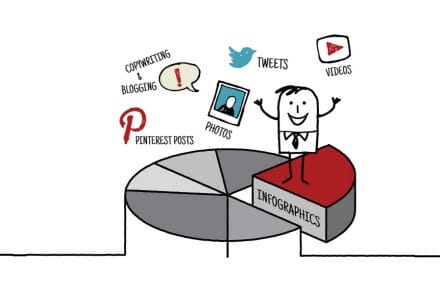Social media offers an amazing platform for customers to engage with brands. When it comes to driving conversion, it often acts in a co-starring role to last click attribution. One supporting act that social media performs to a T is customer education. From building awareness, to differentiating a product and teaching customers how to use it, social media captures the attention of audiences to build awareness and push them along the funnel.
Content can be as simple or creative as you’d like it to be because social networks use multiple media types. These include text only status updates, photos and video. In marketing nothing can be more powerful than a good visual and networks like Instagram and Pinterest have mastered photo sharing.
How can you harness Instagram, Pinterest, Twitter or Facebook to educate customers? Here are three ways to dust off your content strategy and leverage what they have to offer.
1. Just the Facts
People like to receive short digestible information in social media. You only have a few seconds to capture attention and hold it. It can’t feel like it will be too much work for the user. Website content and downloadable white papers are more appropriate formats for long-winded detail. Users expect a bigger time commitment from these versus a social media feed. This is great because it creates an opportunity to repurpose a big piece of content into several short snippets of information. If you don’t have readily made content handy, you can outline a list of “did you know” facts about your product, service or industry to begin building a plan.
A “facts” driven content strategy is good for marketers who:
- Are positioning thought leadership
- Solve a complex problem with a product/service
- Whose product has many uses or complexity use
- Have a brand with historical significance
Ways facts can educate in social media content:
- Text Only: One sentence tip or fun fact. You can even create a hashtag around it like WD-40 did with its 2,000 #WD40uses.
- Visual Content: Create a poster image using interesting photography or illustrations overlaid with a quote. Keep the copy on the image short and expand upon it in the status update.
- Video: Create short videos (under a minute) narrowly focused on one topic or question. “Will it blend?”
2. Visual Storytelling
Visuals are a popular way to tell stories and educate. Most of us social media types are pretty good at hacking graphics but you might find that a photo shoot is in order or that something more involved will need your graphic designer’s touch. A few ways to visually tell a story that educates customers are:
- Infographic focusing on stats, a diagram or themed list, e.g. “The difference between ___ and ___” or “How ____ has changed the ____”
- Short animated video explaining a complex concept in simple terms
- Animated photography with narration or text overlay
- High-impact photography that stands on its own
Like a true storyteller you’ll want a storyboard outlining the journey from start to finish. Be sure to focus on what end result you would like from your audience, “I want them to know or learn___.”
While almost every social network supports photos and video, Pinterest is is unique. Pinterest displays different sized photos with or without text on them without discrimination. Vertically long images like infographics or posters do great. And consider this… Pinterest is the only social network where clicking on a photo results in linking out to a website, where you can expand your story.
3. A Photo Grouping
While a single photo can be worth a thousand words, a group of photos lend creative license for getting your message across. This can happen progressively or in a single display. Each social network has minor differences in their photo features and display. Here are the possibilities:
Facebook performs best with high-impact photographs. Pages will post one photo or multiple photos. Multiple photos display in an album. Facebook frowns upon images containing more than 20% of text. That means memes, quote posters and infographics are not a fit here. For linkable photo groupings, try out the new carousel ads.
Just about anything goes on Twitter. The most interesting feature to play with is the ability to upload up to four photos in a Tweet. The collection displays as a side-by-side square of thumbnails in the feed that individually expand. Rely heavily on the visual because you will be limited to less than 140 characters in a the status update.
Instagram photos should feel organic and generally not contain text, however they have no formal guidelines rejecting text photos. Plan shots that crop well. Make use of interesting angles and filters to add drama to your story. You’ll be relieved to know that Instagram allows for lengthy copy so you can really expand upon your story in the status update. You’ll need it because on Instagram there is no linking out from the photo or copy.
Customer Education Using Social
Social networks provide an amazing platform for customer education. They come with a built-in audience and many creative possibilities using multi-media formats. A customer education focused content strategy can use boiled down facts to position thought leadership or communicate complex information in easy-to-digest snippets. Visual storytelling combines photos, illustrations and words that take customers on a journey. Infographics are a great example of this. When you don’t have a graphic designer handy, you might opt for photography using a single high-impact photo or a grouping.
Have you seen a good example brands doing this well? Tell me about it in a comment.





No Comments
[…] brands have around one post a day. Some build up to four or six. You want an intelligent method for educating your followers about your products and […]